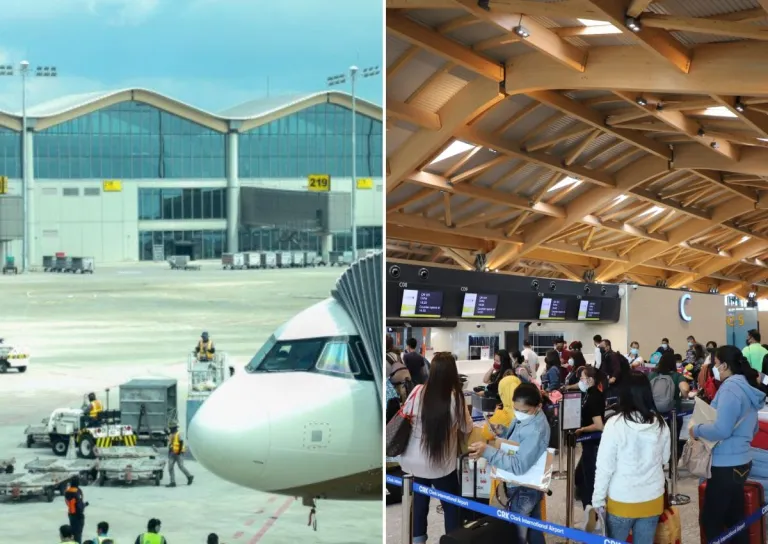Our favourite places to stay on this sleepy Cebu island.
Island Flights from Clark: How NAIA's Overhaul Impacts Your Travel Plans

As the Philippine government eyes the relocation of turboprop flights from Ninoy Aquino International Airport (NAIA) to Clark International Airport, almost three million travellers might soon have to adjust their travel plans. This move is part of a ₱170.6-billion rehabilitation project for NAIA led by San Miguel Corp., which includes converting the existing Terminal 4 into a warehouse and constructing a new terminal nearby.
Also read: Philippine Airlines Announces New Clark to Batanes Route
Island Flights from Clark

Terminal 4 currently serves as the primary hub for turboprop flights connecting to smaller airports such as Coron, Masbate, Naga, and Siargao. In 2023, Terminal 4 handled 2.79 million passengers, with a pre-pandemic peak of 5.74 million in 2019.
Transportation Undersecretary Timothy John Batan has indicated that while there is no definitive order yet for airlines to withdraw their turboprops from NAIA, carriers are encouraged to maximise the use of Clark International Airport. This suggestion aligns with the aim to streamline NAIA’s operations and improve efficiency.
Major airlines like Cebu Pacific and Philippine Airlines (PAL) have expressed their concerns and suggestions regarding this potential policy shift. Cebu Pacific has proposed banning general aviation at NAIA to prioritise commercial flights and emphasised the need to upgrade regional airports to accommodate larger jets like Airbus A320s. PAL, on the other hand, warned that relocating turboprops could disrupt domestic tourism recovery, as some travellers may be deterred from using Clark Airport for departures.
PAL currently operates 18 Bombardier turboprops, while Cebu Pacific has a fleet of 12 ATR 72-600s, two 72-500s, and plans to expand to 16 turboprops by year-end. Cebu Pacific also transports over 2.5 million passengers annually to 25 domestic destinations using these aircraft.
Shifting operations
Some airlines have already started shifting operations to Clark. Boutique carrier Sunlight Air has relocated its headquarters to Clark, and PAL has initiated turboprop services from Clark to Basco, making Clark a jump-off point for trips to Batanes.
Turboprops, typically used for domestic routes ranging between 600 and 1,000 miles, offer advantages like lower fuel consumption due to their slower travel pace. This characteristic makes them ideal for connecting smaller airports across the Philippines.
Also read: Where to Stay in Clark: 10 Best Hotels, Resorts, and Airbnbs For Your Next Weekend Break
As the government continues to negotiate and refine its plans, the aviation landscape in the Philippines may soon see significant changes, potentially making Clark International Airport a central hub for domestic turboprop flights.
All image credit goes to Clark International Airport | Official Website
Published at
About Author
Anne Mercado
Subscribe our Newsletter
Get our weekly tips and travel news!
Recommended Articles
10 Bantayan Island Resorts, Hotels, and Rentals for Your Tropical Escape 14 Best Credit Cards for Travel in the Philippines The only plastic we need for travel.
10 Best Mountain Cafes in the Philippines for Your Peak Coffee Experience Coffee date on the mountains, anyone?
10 Family Outing Ideas in Metro Manila Under ₱500 Looking for a weekend bonding with the family under ₱500? Head to these places, pronto!
10 Fun Things to Do in Manila Alone Live your best life in Manila, even when you’re riding solo.
Latest Articles
Legoland Shanghai Opening in 2025: What to Expect New theme park alert in China
Pahiyas Festival 2025: A Vibrant Celebration in Lucban Quezon Pahiyas is back and brighter than ever!
Top 10 Family-Friendly Things to Do in Europe Unmissable experiences for all ages
Scoot’s Direct Flights from Singapore to Iloilo Are Finally Here — Here’s What You Need to Know Fly direct from Singapore to Iloilo with Scoot!
Cheung Chau Bun Festival 2025: Where to Go, What to Do, and How to Join Experience the thrill of the Cheung Chau Bun Festival 2025

